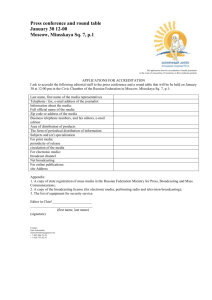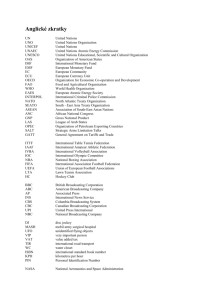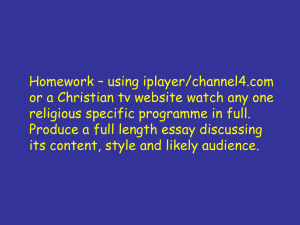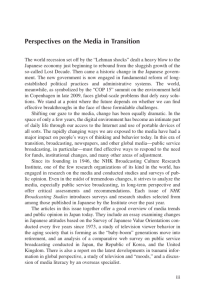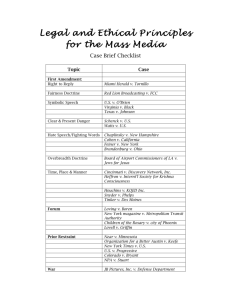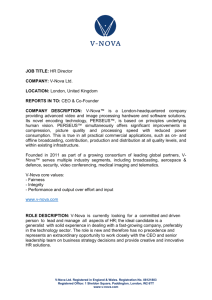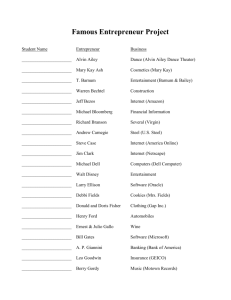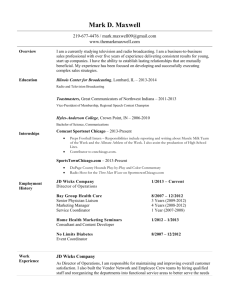course outline
advertisement
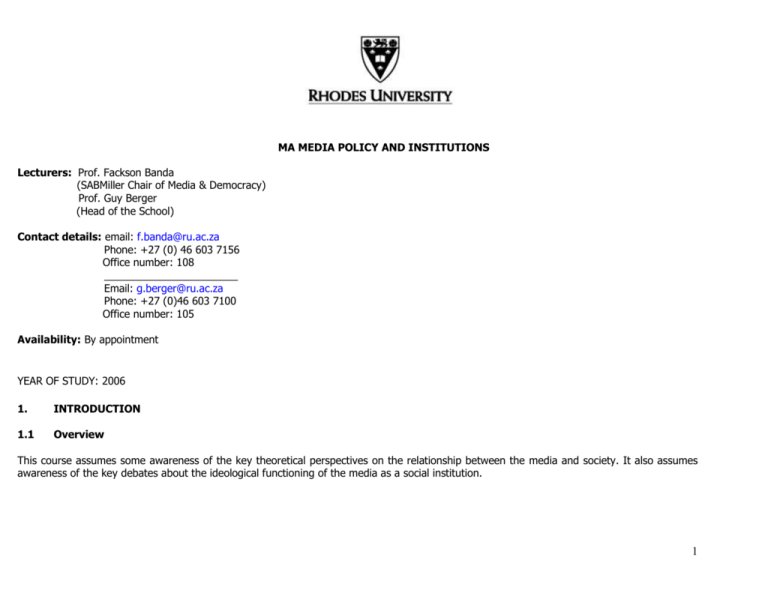
MA MEDIA POLICY AND INSTITUTIONS Lecturers: Prof. Fackson Banda (SABMiller Chair of Media & Democracy) Prof. Guy Berger (Head of the School) Contact details: email: f.banda@ru.ac.za Phone: +27 (0) 46 603 7156 Office number: 108 _______________________ Email: g.berger@ru.ac.za Phone: +27 (0)46 603 7100 Office number: 105 Availability: By appointment YEAR OF STUDY: 2006 1. INTRODUCTION 1.1 Overview This course assumes some awareness of the key theoretical perspectives on the relationship between the media and society. It also assumes awareness of the key debates about the ideological functioning of the media as a social institution. 1 The course thus preoccupies itself with the media as a social institution answering to specific internal and external media policies. To this end, the concepts of ‘media institution’ and ‘media policy’ are defined within particular theoretical traditions. Picking up the discussion about media institutions, the course undertakes an institutional analysis of journalism in order to disentangle the “ideo-institutional” underpinnings of news production. The definitions of ‘media policy’ are extended to embrace such things as the domain, scope, goals, context, and process of policy application. Internal media policy and external media policy are compared and contrasted. The economic and other factors impinging on both are analysed. Furthermore, the course discusses the theoretical underpinnings of media regulation in order to understand the rationale for regulating media institutions. In particular, it analyses the various regulatory and policy models of broadcasting, focusing on public service broadcasting (PSB). African country-specific examples of broadcast media regulation, especially public service broadcasting, are given in order to assist students to understand the historical and cultural specificities of media policy and media institutions. The course also presents the discourse of the “Information Society” as an analytical tool for discussing issues of media policy and regulation both in Africa and in the developed world. 1.2 Credit Value 12.5 credit value is ear-marked for this course. 1.3 Assumptions of Prior Learning As noted above, this course builds on the Media and Society course, in particular theoretical debates about the media and society. It also assumes familiarity with the key debates about the ideological functioning of the media as a social institution, especially such analytical approaches as semiotics, narrative, genre and critical discourse analysis. This should position students to see the media as an organic aspect of the nexus of social institutions, and not as a socially dislocated ‘fact out there’. 2. OUTCOMES 2.1 Specific Intended Outcomes By the end of this course, students should be able to: 2 a) discuss theoretical models of media institutions, and apply them in undertaking an institutional analysis of the occupation of journalism b) define the concept of policy and demonstrate that various other definitions exist that highlight key aspects of the nature of policy c) deploy specific theoretical models in articulating and contrasting media policy and communication policy d) differentiate between external and internal media policy e) identify, describe and discuss the key economic and other trends that impinge on the formulation and implementation of media policy f) define media regulation from specific theoretical positions g) pinpoint, evaluate and give examples of various regulatory models of broadcasting, with specific emphasis on public service broadcasting (PSB) h) use the above models to critically debate issues relating to public service broadcasting as practised in Africa (i.e. South Africa and Zambia) i) analyse and discuss policy and regulatory issues about the “Information Society”, including technological convergence and its impact on internal “multiskilling” policies/practices 2.2 Critical Cross-Field Outcomes Students will be able to: a) b) c) d) e) identify and solve problems work in a team collect, analyse and evaluate information communicate effectively participate as a responsible citizen 3. TEACHING METHODS a) Weekly lecture, followed by a class discussion b) Weekly seminar, based on a student presentation whose topic and readings will have been given in the preceding week 3 4. COURSE CONTENT Timetable: MA Media policy and institutions Date 21st April Topic The Information Society: sketching policy and institutional issues Main features of lecture The Information Society and its relevance to media policy Policy prescriptions related to different conceptions of the Information Society Resources Required readings: Darlington, R. nd. Fascinating facts and figures about all aspects of the Information Society. http://www.rogerdarlington.co.uk/FFF.html Webster, F. 2000. Theories of the Information Society. London: Routledge. Berger, G. 2003. Interrogate the Information Society. Rhodes Journalism Review, December, no 23, 7-11. Supplementary readings: Castells, M. 2000. The Rise of the Network Society. (2nd ed). London: Blackwell. Castells, M. 2001. Information technology and global development. In Muller, J et al, 2001. Challenges of globalisation. South African debates with Manuel Castells. Cape Town: Maskew Miller Longman. Van Audenhove, L. (2003) ‘Theories of the Information society. Recent contributions and their relevance for the developing world’, Communicatio Special Edition, vol.29; N°1&2, 48-67. Van Audenhove, L., Burgelman, J.C. & Cammaerts, B. & Nulens, G. 2003. ‘Discourse and Reality in International Information Society Policy. The dominant scenario and its application in the developing world’. Communicatio Special Edition, vol.29; N°1&2, 79-113. Berger, G. 2003. Whassup with Wsis? Mail and Guardian Online. 13 August 2003. Berger, G. 2005. Internet anytime, anywhere, by anyone Facilitator Prof. G. Berger 4 28th April Introduction to media institutions Theoretical perspectives on media institutions a) Liberal pluralism model b) Critical political economy model c) ‘Theorising’ media institutions in Africa: Insights from Amitai Etzioni’s (responsive) communitarianism model Media institutions: sources of external constraint & control Media institutions and society: an institutional analysis of journalism & news production -- except Tunisia http://www.mg.co.za/articlePage.aspx?articleid=257469& area=/insight/insight__columnists/ Klein, H. 2003. Understanding Wsis. An institutional analysis of the UN World Summit on the Information Society. Internet and Public Policy project, School of public policy, Georgia Institute of Technology. www.ip3.gatech.edu Accessed 20 December 2003. http://www.itu.int/wsis/ http://www.wsis-online.net/ http://portal.unesco.org/ci/en/ev.phpURL_ID=1543&URL_DO=DO_TOPIC&URL_SECTION=201 .html Required readings: Branston, G & Stafford, R. 2003. The media student’s book. 3rd edition. London and New York: Routledge: 182-202; 473-488. (or the 1996 edition in the Rhodes University library). Read, in particular, the chapters on ‘institutions’. Etzioni, A. 2003. A 308. Communitarianism, in Prof. F. Banda Encyclopedia of community: from the village to the virtual world. Vol 1, A-D edited by K Christensen & D Levinson. Thousand Oaks, Calif.: Sage: 224-228. Fourie, PJ. 2001. Characteristics, trends and the political economy of the media, in Media studies. Volume 1: Institutions, theories and issues, edited by PJ Fourie. Lansdowne: Juta. For an extended discussion of journalism as an institution, see McNair, B. 2001. The sociology of journalism. London: Arnold: 3-18; 61-81. Supplementary readings: Curran, J. 1998. Newspapers: beyond political economy, 5 5th May Introduction to media policy Definitional features of policy a) Domain of policy application b) Scope of policy application c) Goals of policy d) Measures to achieve goals e) Contextual framework for in The media: an introduction, edited by A Briggs & P Cobley. New York: Longman. Bell, D. 1994. Communitarianism and its critics. Oxford: Oxford University Press. Paul, EF, Miller, FD & Paul, J (eds). 1996. The communitarian challenge to liberalism. Cambridge: Cambridge University Press. For an analysis of the differences between ‘media institution’ and ‘media organisation’, see McQuail, D. 1987. Mass communication theory: an introduction. 2nd edition. London: Sage: 137-171. For a radical analysis of the relationship between ownership and control of media institutions and their news-producing ‘function’, see Goldsmiths Media Group. 2000. Media organisations in society: central issues, in Media organisations in society edited by J Curran. London: Arnold, as well as Golding, P & Elliot, P. 1995. News departments and broadcasting organizations – the institutionalization of objectivity, in Approaches to media. A reader, edited by O Boyd-Barrett & C Newbold. London: Arnold. Schudson, M. 2000. The sociology of news production revisited (again), in Mass media and society, edited by J Curran & M Gurevitch. New York: Oxford University Press: 175-200. Required readings: Swanepoel, P. 1998. Master degree of arts in Prof. F. Banda international communication: working with policy documents. Pretoria: UNISA. Parsons, W. 1995. Public policy: an introduction to the theory and practice of policy analysis. Aldershot and Brookfield: Edward Elgar: xv-xvi, 2-29 6 12th May Media regulation policy f) Process of policy formulation Theoretical approaches to (media) policy Contrasting ‘media policy’ with ‘communication policy’ Internal and external media policy Some social, political, economic & technological influences on media policy a) Democratisation b) Liberalisation c) Deregulation d) Privatisation e) Commercialisation f) Internationalisation g) Convergence h) Communitarianism Theoretical definitions of (media) regulation Justification for media regulation Historical background to media regulation Economic trends impinging on media regulation a) De-regulation b) Re-regulation Oosthuizen, LM. 2001. The external media policy framework: from restrictive policy to the democratization of communication, in Media studies. Volume 1: Institutions, theories and issues edited by PJ Fourie. Lansdowne: Juta: 163-207. Supplementary readings: For a more ‘theoretical’ discussion of policy, see Banda, F. 2003. Community radio broadcasting in Zambia: a policy perspective. PhD thesis. University of South Africa, Pretoria. [0]. Available: http://etd.unisa.ac.za/ETDdb/ETD-esc/describe?urn=etd-07122004-110440 Garnham, N. 1998. Media policy, in The media: an introduction, edited by A Briggs & P Cobley. New York: Longman. For a general discussion of media policy, see Oosthuizen, LM. 1989. Media policy and ethics. Kenwyn: Juta & Co Ltd., and/or For a discussion of (international) influences on media policy, see Steyn, E. 1998. Media policy: frameworks for an expanding world, in Mass media –Towards the new millennium, edited by AS de Beer. Pretoria: J.L. van schaik. Required readings: Prof. F. Banda Branston, G & Stafford, R. 2003. The media student’s book. 3rd edition. London and New York: Routledge: 182-202; 473-488. Horwitz, RB. 1997. Theories of regulation, in The political economy of the media edited by P Golding & G Murdock. Cheltenham: Edward Elgar Keane, J. 1991. The media and democracy. Cambridge: Polity Press: 51-91. Supplementary readings: 7 19th May Media regulation: broadcasting c) Concentration d) Convergence e) Commercialisation f) Liberalisation g) Privatisation h) Internationalisation Contemporary media regulatory models a) State intervention b) Independent regulation c) Self-regulation d) Legal framework e) ‘Market forces’ f) ‘Audience pressure’ Regulation and the ‘public interest’ Justification for broadcast media regulation The nature of broadcast regulation a) Structural regulation (broadcasting system and institutional arrangements) b) Behavioural/performance regulation (programming and content issues) Broadcast regulation and the challenge of ICTs Golding, P. New technologies and old problems: evaluating and regulating media performance in the ‘information age’, in The political economy of the media edited by P Golding & G Murdock. Cheltenham: Edward Elgar. McQuail, D & Siune, K (eds).1998. Media policy: convergence, concentration & commerce. London: Sage: 7-38, 180-207. Required readings: Branston, G & Stafford, R. 2003. The media student’s book. 3rd edition. London and New York: Routledge: 182-202; 473-488. Hills, J. 2003. Regulatory models for broadcasting in Africa, in Broadcasting policy and practice in Africa edited by T Kupe. London: Article 19: 34-70. Supplementary readings: Dahlgren, P. 1995. Television and the public sphere: citizenship, democracy and the media. London: Sage. Goldsmiths Media Group. 2000. Media organisations in society: central issues, in Media organisations in society edited by J Curran. London: Arnold. Mansell, R. 1999. New media competition and access: the scarcity-abundance dialectic. New media & society 1(2):155-182. Prof. F. Banda 8 26th May Public service broadcasting (PSB) Definition of public service broadcasting A brief history of PSB Regulatory models for PSB PSB and the public sphere PSB and commercialism Funding models for PSB Required readings: Raboy, M. 1996. The world situation of public service broadcasting: overview and analysis, in Public service Prof. F. Banda broadcasting: cultural and educational dimensions. Paris: UNESCO: 21-56. Betzel, M & Ward, D. 2004. The regulation of public service broadcasters in Western Europe. Trends in Communication 12(1): 47-62. [O]. Available: Rhodes Library EBSCOHOST database. Fourie, PJ. [Sa]. Leapfrogging into the market approach: the loss of public service broadcasting for development and nation building. Pretoria: [sn]. [0]. Available: http://www.pucrs.br/famecos/iamcr/textos/fourie.pdf. Accessed on 20/03/2006. Supplementary readings: Mbaine, EA. 2003. Viability and sustainability of public service broadcasting, in Broadcasting policy and practice in Africa edited by T Kupe. London: Article 19. Boyd-Barrett, O & Newbold, C. 1995. Approaches to media. A reader. London: Arnold: 230-263. 9 2nd June Public service broadcasting (PSB) debates in the African context: the case of Zambia 12th June Broadcast media landscape issues: the case of South Africa A brief introduction to the broadcast media landscape in Zambia a) Colonial period b) The ‘Second Republic’ period c) The ‘Third Republic’ period ‘State’ or ‘public’ broadcasting? ‘New’ issues in broadcast regulation and policy IBA Act (student presentations) Triple Enquiry (student presentations) Green Paper (student presentations) White Paper (student presentations) Broadcasting Act 1999 (student presentations) SABC re-licensing application Required readings: Banda, F. 2003. Community radio Prof. F. Banda broadcasting in Zambia: a policy perspective. PhD thesis. University of South Africa, Pretoria. [0]. Available: http://etd.unisa.ac.za/ETD-db/ETDesc/describe?urn=etd-07122004-110440. [Moodle] Kupe, T. (ed). 2003. Broadcasting policy and practice in Africa. London: Article 19: 1-6; 34-70. [Moodle] Ministry of Information & Broadcasting Services (MIBS). 1996. Information and media policy. Lusaka: MIBS. [Moodle] Required readings: Horwitz, RB. 2005. ‘Negotiated Prof. G. Berger liberalization’: stakeholder politics and communication sector reform in South Africa. Vol.1, 24 September. [0]. Available: http://arxiv.org/html/cs.CY/0109097.htm. Jjuuko, D. 2005 Historical Context of the SABC and its Transformation into a Public Broadcaster. (Chapter Four – MA thesis, 2005). Fourie, PJ. [Sa]. Leapfrogging into the market approach: the loss of public service broadcasting for development and nation building. Pretoria: [sn]. Triple Inquiry. 1994. List Of Submissions Received For The Triple Inquiry Into Public Broadcasting, Local Content And Cross 10 Media Control http://www.icasa.org.za/Default.aspx?pag e=1271&moduledata=577 SABC. 2004. Application for amendment of sabc licences in terms of section 22 of the Broadcasting Act number 4 of 1999 http://www.icasa.org.za/Documents.aspx? Page=63 15th June Internal SABC policies 19th June Convergence An overview of SABC’s internal policy documents Policies review: news Policies review: a) Programme b) Language c) Local content d) Education e) Religion Information policy and convergence Content management systems, databases and convergence Required readings: SABC’s policy documents http://www.sabc.co.za/portal/site/corpor ate/menuitem.f7f580ebd1506ee48891f2e 75401aeb9/ Berger, G. Reconciling Editorial Independence and Public Accountability Issues in Public Broadcasting Service: Editorial Policies at South African Broadcasting Corporation. http://journ.ru.ac.za/staff/guy/fulltext/ai dbberger.doc Required readings: Berger, G. 2000. Configuring convergence. Grahamstown: Rhodes University New Media Lab. (excerpts) McPhie, E. 2003. Convergence: technological change and effective regulation can bring benefits to the developing world. [0]. Available: http://www.bridges.org/epolicy/convergence/index.html. Accessed on 10/01/2004. Prof. G. Berger Prof. G. Berger Vincent Maher 11 Gordon, R. 2003. Convergence defined, in Digital Journalism: emerging media and the changing horizons of journalism edited by K. Kwamoto. [sn]: Rowman and Littlefield. [0]. Available: www.ojr.org/ojr/business/1068686368. php. Accessed on 10/01/2004. Vodacom takes on DSTV. http://www.sundaytimes.co.za/articles/ article-business.aspx?ID=ST6A172950 Supplementary readings: Mlitwa, N. 2004. Implications of convergence on the regulatory regime, e-Commerce, the industry, and the society at large in South Africa. http://eprints.rclis.org/archive/000042 32/01/Implications_of_Convergence_o n_the_Regulatory_Regime.pdf 22nd June Convergence law The long history of the Electronic Communications Act and the Icasa Amendment Act Regulating TV via cellphones a) Icasa b) Waspa c) Cellular companies d) Religious groups e) Independent Elections Authority f) FXI g) Newspapers and magazines h) Etv Required readings: Berger, G. 2003. Convergence cometh. [0]. Available: http://www.mg.co.za Department of Communications. 2003. Prof. G. Berger Convergence Bill. Berger, G. Confusing convergence. [0]. Available: http://www.mg.co.za Berger, G. Why Icasa could become icasa. http://www.mg.co.za/articlePage.aspx? articleid=254863&area=/insight/insight __columnists/ 12 i) SABC 28th June Internal policy on convergence and multiskilling Convergence and multimedia Berger, G. Convergence – the search for speed. http://www.mg.co.za/articlePage.aspx? articleid=252192&area=/insight/insight __converse/ Icasa documents on regulating cellular content: http://www.icasa.org.za/Documents.a spx?Page=63 Required readings: Prof. G. Berger Berger, G. 2001. Configuring convergence. chapters 4 -8; http://journ.ru.ac.za/staff/guy/fulltext/ configure.htm Deuze, M. 2004. What is multimedia journalism? Journalism Studies, 5(2)139-152 Outing, S. 2004. Who Produces World's Best Web Infographics? Arguably, Spain's El Mundo. A case study on how to produce compelling multimedia packages quickly. (sn) Kennedy, H. 2002. Postgraduate multimedia education: practices, themes and issues. www.ecdc.nl/publications/reports/cmd _benchmark.pdf Prior, L. 2005. A converged curriculum. http://www.ojr.org/ojr/stories/050224 pryor 13 4th August 5. Internal policy on convergence and multiskilling Presentations on a convergence policy for Course evaluation STUDENT ASSESSMENT 5.1 Assignment One: At the beginning of the lecture sessions for this course, you will be given a topic on a theoretical approach to the study of media policy and institutions. You will be required to write a short paper and present it for some 20 minutes during a seminar session. Specific Outcomes 1. Articulate and contextualise media policy and institutional theories 2. Apply such theories to an institutional analysis of the occupation of journalism and/or the Information Society 5.2 Prof. G. Berger Grocott’s Mail. Assignment two (essay): Assessment Criteria 1. Outline the theory clearly, cogently and correctly 2. Place the theory within the wider context of media and society debates 3. Critical assessment of the theory in relation to news production values 4. Evidence of having read literature specified in the course material 5. Presentation (structure, cohesion, coherence, argumentation, evidence, explicitness, positioning, tentativeness, etc.) Assessment Tasks A written paper, to be presented and defended during a seminar session (10%) Due Date During an allotted seminar session Choose a policy document based on an aspect of the media in either South Africa or Zambia. Analyse the policy document in terms of the following concepts: (i) the domain of policy application; (ii) the scope of policy application; (iii) the goals of the policy; (iv) the measures used to achieve the policy goals; (v) the contextual framework for policy; and (vi) the process of policy formulation, implementation and evaluation. 14 Specific Outcomes 1. Demonstrate a critical understanding of (media) policy as a process and output 2. Apply such knowledge in an analysis of a specific media policy document 3. Show an understanding of the social, political, economic and technological contexts for policy formulation, implementation and evaluation 5.3 Assignment three: Assessment Criteria 1. Identification and choice of a relevant media policy document 2. Correct overview of what the policy document is about 3. Critical and correct application of the concepts learnt in class to the policy document 4. Broad literature search, as shown through referencing 5. Conforming to academic register (structure, cohesion, coherence, argumentation, evidence, explicitness, positioning, tentativeness, grammar, punctuation, referencing, etc.) Assessment Tasks Essay of up to 2500 words (30%) Due Date 26th May 2006 You will be assessed on your presentations as regards: Broadcast media landscape in South Africa, SABC policy reviews, and convergence policy for Grocott’s Mail. Specific Outcomes 1. Present a reflective analysis of the three aspects of the South African media landscape above as agreed with your lecturer 2. Demonstrate a familiarity with appropriate literature on the subject Assessment Criteria 1. Knowledge of the area studied in class 2. Comprehensiveness in approach 3. Coherence and depth of focus 4. Adherence to academic protocols of style 5. Clarity and skill in presentation Assessment Tasks 3 presentations - which will lead to 2 short papers and power-point presentations (30% made of 10% for each of three presentations) The papers are expected to be up to 2500 words Due Date On the scheduled days. 15 5.4 Final examination Specific Outcomes Assessment Criteria Assessment Tasks 1. Discuss the concept of media policy, and related 1. Outline media policy and regulatory Final examination (30%) sub-concepts, knowledgeably concepts clearly, correctly and concisely 2. Describe and discuss the main economic and other 2. Place such concepts in the wider context of trends that impinge on media policy and institutions debates about media institutions and 3. Discuss media regulation theories and apply them to society any African country of the student’s choice 3. Give examples of media regulatory 4. Give examples and evaluate models of broadcast practices across Africa, as studied in class media regulation 4. Position public service broadcasting within 5. Use the above models to critically debate issues media regulatory models studied relating to broadcasting and the Information Society 5. Critically elaborate upon trends impinging on media institutions and media policy formulation 6. Presentation (grammar, clarity, spelling, punctuation, etc.) 6. Due Date 14th August 2006 EVALUATION This course will be subjected to a summative evaluation, in the form of reflection questions based on the format of the Academic Development Centre. The findings of this exercise will be used to determine any adjustments to the course content, pedagogical methods, etc. However, throughout the course, there will be some informal “formative” evaluation in the form of impromptu questions in order to help the lecturers readjust their teaching styles, aid materials, etc. 7. GENERAL REMARKS Students are expected to read, in preparation for each lecture. The lectures will be used to introduce the subject. It is expected that students will conduct independent reading/research to enrich lecture and seminar presentations. 16 All written assignments are expected to adhere, as strictly as possible, to the Harvard method of referencing. A document to this end will have been distributed by the MA Course Coordinator. In case of any difficulty, please feel free to consult with the lecturers concerned for advice. 17
